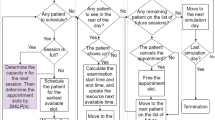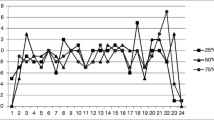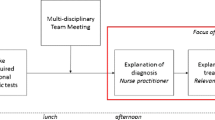Abstract
An important challenge confronting healthcare is the effective management of access to primary care. Appointment scheduling policies/templates can help strike an effective balance between the lead-time to an appointment (a.k.a. indirect waiting time, measuring the difference between a patient’s desired and actual appointment dates) and waiting times at the clinic on the day of the appointment (a.k.a. direct waiting time). We propose methods for identifying effective appointment scheduling templates using a two-stage stochastic mixed-integer linear program model. The model embeds simulation for accurate evaluation of direct waiting times and uses sample average approximation method for computational efficiency. The model accounts for patients’ no-show behaviors, provider availability, overbooking, demand uncertainty, and overtime constraints. The model allows the scheduling templates to be potentially updated at regular intervals while minimizing the patient expected waiting times and balancing provider utilization. Proposed methods are validated using data from the U.S. Department of Veterans Affairs (VA) primary care clinics.


















Similar content being viewed by others
References
Anderson RT, Camacho FT, Balkrishnan R (2007) Willing to wait? the influence of patient wait time on satisfaction with primary care. BMC Health Serv Res 7(1):31
Anvaryazdi SF, Venkatachalam S, Chinnam RB (2020) Appointment scheduling at outpatient clinics using two-stage stochastic programming approach. IEEE Access 8:175297–175305
Bodenheimer T, Pham HH (2010) Primary care: current problems and proposed solutions. Health Aff 29(5):799–805
Cayirli T, Veral E, Rosen H (2006) Designing appointment scheduling systems for ambulatory care services. Health Care Manag Sci 9(1):47–58
Chakraborty S, Muthuraman K, Lawley M (2013) Sequential clinical scheduling with patient no-show: the impact of pre-defined slot structures. Socio Econ Plan Sci 47(3):205–219
Dixon CA, Punguyire D, Mahabee-Gittens M, Ho M, Lindsell CJ (2015) Patient flow analysis in resource-limited settings: a practical tutorial and case study. Glob Health Sci Pract 3(1):126–134
Dobson G, Hasija S, Pinker EJ (2011) Reserving capacity for urgent patients in primary care. Prod Oper Manag 20(3):456–473
Festinger DS, Lamb R, Marlowe DB, Kirby KC (2002) From telephone to office: Intake attendance as a function of appointment delay. Addict Behav 27(1):131–137
Gallucci G, Swartz W, Hackerman F (2005) Brief reports: impact of the wait for an initial appointment on the rate of kept appointments at a mental health center. Psychiatr Serv
The american academy of family physicians. primary care. http://aafp.org/about/policies/all/primary-care.html
Green LV, Savin S (2008) Reducing delays for medical appointments: a queueing approach. Oper Res 56(6):1526–1538
Gupta D, Denton B (2008) Appointment scheduling in health care: challenges and opportunities. IIE Trans 40(9):800–819
Gupta D, Wang L (2008) Revenue management for a primary-care clinic in the presence of patient choice. Oper Res 56(3):576–592
Hedges L, Couey C (2013) Patient use of online reviews
Kaplan G, Lopez MH, McGinnis JM (2015) Transforming health care scheduling and access: Getting to now. Washington DC: Institute of Medicine
Kopach R, DeLaurentis PC, Lawley M, Muthuraman K, Ozsen L, Rardin R, Wan H, Intrevado P, Qu X, Willis D (2007) Effects of clinical characteristics on successful open access scheduling. Health Care Manag Sci 10(2):111–124
Krause K, Pollak K, Gradison M, Michener J, Michener J (2009) Family physicians as team leaders: ’time’ to share the care
LaGanga LR, Lawrence SR (2012) Appointment overbooking in health care clinics to improve patient service and clinic performance. Prod Oper Manag 21(5):874–888
Liaw WR, Jetty A, Petterson SM, Peterson LE, Bazemore AW (2016) Solo and small practices: a vital, diverse part of primary care. Ann Fam Med 14(1):8–15
Linderoth J, Shapiro A, Wright S (2006) The empirical behavior of sampling methods for stochastic programming. Ann Oper Res 142(1):215–241
Liu N, Ziya S, Kulkarni VG (2010) Dynamic scheduling of outpatient appointments under patient no-shows and cancellations. Manuf Serv Oper Manag 12(2):347–364
Luo J, Kulkarni VG, Ziya S (2015) A tandem queueing model for an appointment-based service system. Queueing Syst 79(1):53–85
Mak WK, Morton DP, Wood RK (1999) Monte carlo bounding techniques for determining solution quality in stochastic programs. Oper Res Lett 24(1-2):47–56
McCarthy D, How SKH, Fryer AK, Radley DC, Schoen C (2011) Why not the best? Results from the national scorecard on U.S. health system performance
Merritt Hawkins Team (2014) Physician appointment wait times and medicaid and medicare acceptance rates
Morgan PA, Abbott DH, McNeil RB, Fisher DA (2012) Characteristics of primary care office visits to nurse practitioners, physician assistants and physicians in United States veterans health administration facilities, 2005 to 2010: a retrospective cross-sectional analysis. Hum Resour Health 10(1):1
Muthuraman K, Lawley M (2008) A stochastic overbooking model for outpatient clinical scheduling with no-shows. Iie Trans 40(9):820–837
NACHC (2014) Access is the answer: community health centers, primary care & the future of american health care
Oh HJ, Muriel A, Balasubramanian H, Atkinson K, Ptaszkiewicz T (2013) Guidelines for scheduling in primary care under different patient types and stochastic nurse and provider service times. IIE Trans Healthc Syst Eng 3(4):263–279
Pomerantz A, Cole BH, Watts BV, Weeks WB (2008) Improving efficiency and access to mental health care: Combining integrated care and advanced access. Gen Hosp Psychiatry 30(6):546–551
Prentice JC, Pizer SD (2007) Delayed access to health care and mortality. Health Serv Res 42(2):644–662
Qu X, Rardin RL, Williams JAS (2012) A mean–variance model to optimize the fixed versus open appointment percentages in open access scheduling systems. Decis Support Syst 53(3):554–564
Wang WY, Gupta D (2011) Adaptive appointment systems with patient preferences. Manuf Serv Oper Manag 13(3):373–389
Wellstood K, Wilson K, Eyles J (2006) Reasonable access to primary care: assessing the role of individual and system characteristics. Health Place 12(2):121–130
Wilensky GR (2016) The va continues to struggle–especially in terms of improved access. https://www.milbank.org/quarterly/articles/va-continues-struggle-especially-terms-improved-access/
Zacharias C, Pinedo M (2014) Appointment scheduling with no-shows and overbooking. Prod Oper Manag 23(5):788–801
Zeng B, Turkcan A, Lin J, Lawley M (2010) Clinic scheduling models with overbooking for patients with heterogeneous no-show probabilities. Ann Oper Res 178(1):121–144
Acknowledgements
We thank the U.S. Veteran’s Health Administration for sponsoring part of this research.
Author information
Authors and Affiliations
Corresponding author
Ethics declarations
Conflict of interests
The authors declare that they have no conflict of interest.
Additional information
Publisher’s note
Springer Nature remains neutral with regard to jurisdictional claims in published maps and institutional affiliations.
Appendix A
Appendix A
In this section, we provide a step-by-step example of the two-stage stochastic optimization approach for appointment scheduling in an outpatient clinic. Figure 19 represents a step-by-step example of our optimization approach for appointment scheduling. In this example, we assume that there are two working days per week each having two sessions (morning and afternoon) and four appointment slots per day. There are three patient types: Acute (A), Chronic (C), and Preventive (P). We use the parameters of base case study such as: threshold for patient direct waiting time (≤ 30 minutes); threshold for provider over time work spillover from morning session into lunch hour (≤ 45 minutes); threshold for provider over time work after second session of the day (≤ 60 minutes). The patients that are already scheduled are shown in red and patients that can be scheduled are shown in purple. For example in iteration 1, one acute patient is already scheduled in slot 1 of day 1 and one preventive patient is already scheduled in slot 6 of day 2. For simplicity, we only show first-stage of two-stage stochastic optimization in iterations 2 and 5.
We added a step-by-step example in the appendix to demonstrate the details of the index policy as shown in Fig. 20.
Rights and permissions
About this article
Cite this article
Faridimehr, S., Venkatachalam, S. & Chinnam, R.B. Managing access to primary care clinics using scheduling templates. Health Care Manag Sci 24, 482–498 (2021). https://doi.org/10.1007/s10729-020-09535-z
Received:
Accepted:
Published:
Issue Date:
DOI: https://doi.org/10.1007/s10729-020-09535-z






